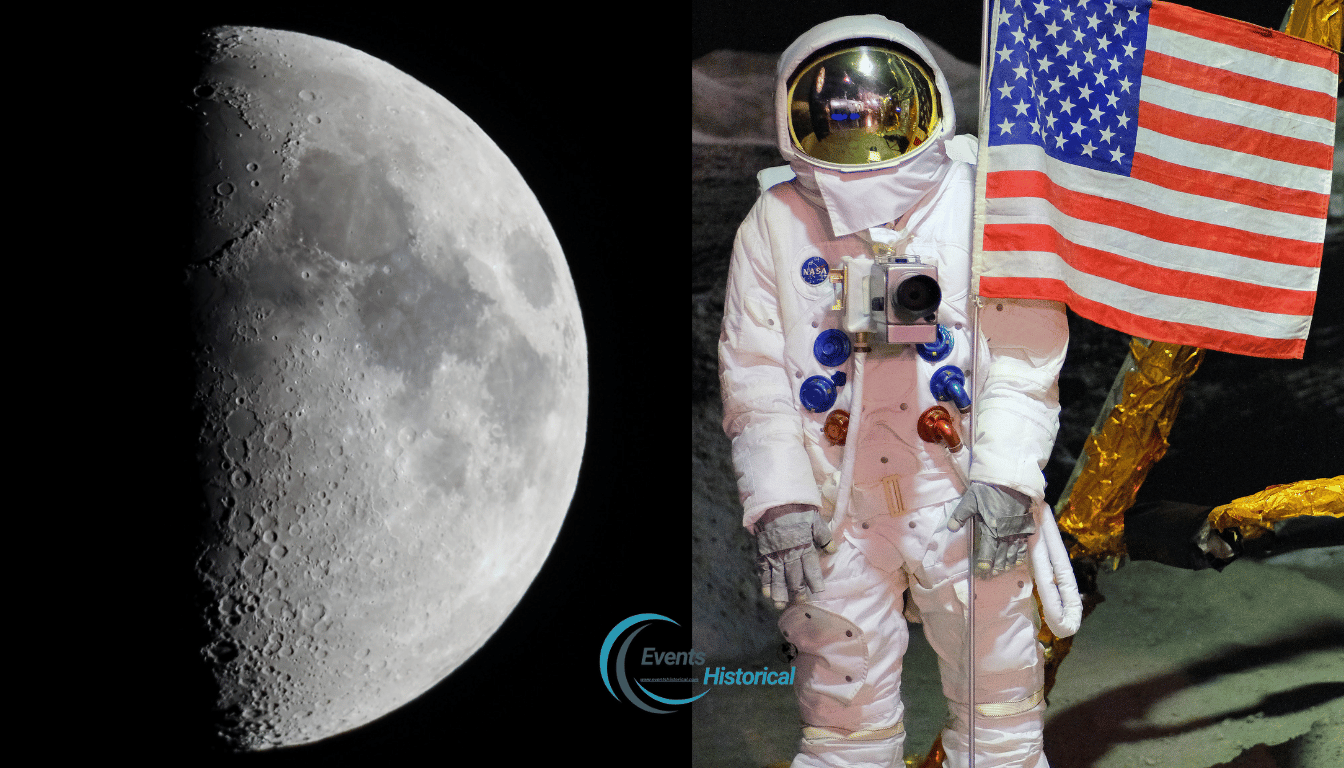Discover how Apollo 11 and the first man on the moon reshaped our approach to space exploration forever, marking a pinnacle in human history.
What if the first man on the moon was more than just a big achievement? It was a wake-up call to the endless possibilities of space. The Apollo 11 mission, launched on July 16, 1969, marked a historic moment. It was a blend of scientific breakthroughs and the urgency of the Cold War.
Neil Armstrong’s first steps on the moon were a turning point. He said, “That’s one small step for man, one giant leap for mankind.” This moment was not just a national victory but a spark for future space exploration. The moon samples gave us new insights into our solar system’s origins. The tech from Apollo 11 has changed our daily lives, pushing us to explore more.
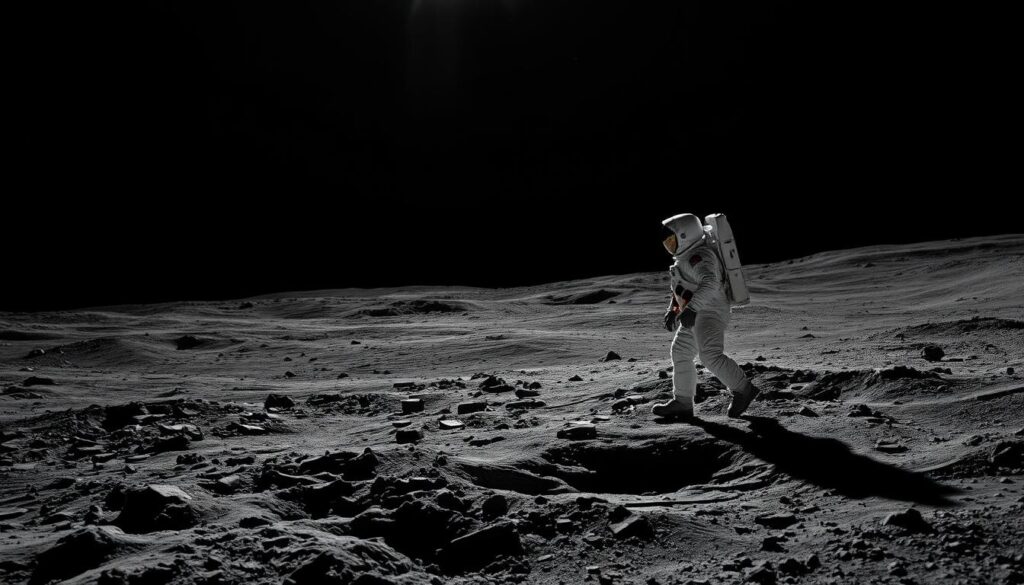
This article explores Apollo 11’s lasting impact. It shows how it went beyond space travel and inspired many to dream big.
Key Takeaways
- Apollo 11 took four days to reach the moon, landing on July 20, 1969.
- Neil Armstrong became the first human to walk on the lunar surface.
- The mission gathered essential rock and soil samples from the moon.
- Technological advancements from Apollo 11 have had lasting societal impacts.
- The mission inspired a global movement towards ambitious goals and environmental awareness.
- Approximately 400,000 individuals worked on the Apollo program, showcasing a massive collaborative effort.
- JoAnn Morgan was a pioneer as the only woman in senior personnel at the Apollo 11 launch control.
The Significance of the Apollo 11 Mission
The Apollo 11 mission was more than just a lunar landing in 1969. It showed human ingenuity and scientific exploration at their best. Over 400,000 Americans worked together on the Apollo program, showing national unity. The U.S. spent over 4% of its budget on space in 1965 and 1966, showing its commitment to innovation.
The lunar landing on July 20, 1969, proved America’s tech leadership. Neil Armstrong and Buzz Aldrin’s moon steps were watched by 500 million people. Armstrong’s words, “That’s one small step for man, one giant leap for mankind,” brought hope and unity.
The U.S. and the Soviet Union raced to the moon, with the U.S. leading. This rivalry boosted national pride and showed the Cold War’s impact. By 1991, the Soviet Union’s fall showed the Apollo program’s lasting impact.
Apollo’s legacy has greatly influenced education and careers. It led to more engineering and science PhDs. The mission’s tech advancements have also helped society in many ways.
The Apollo 11 samples are still studied, giving us insights into the Moon. The mission’s Earthrise image also raised global environmental awareness. Apollo 11’s impact is clear, inspiring innovation and marking a key moment in history.
Cultural Impact of the First Man on the Moon
The moon landing on July 20, 1969, was a huge moment in history. It had a big cultural impact that reached across the world. Neil Armstrong, the first man on the moon, said, “That’s one small step for man, one giant leap for mankind.” This event amazed millions and sparked a lot of media attention and talks about space.
The moon landing became a big topic in the media. It was featured in movies, TV shows, and documentaries. The images of astronauts on the moon have changed how we tell stories. They mix exploration and overcoming big challenges.
Armstrong’s steps on the moon also brought people together during tough times. The Apollo 11 mission has led to talks about science, technology, and big issues like equality and the environment. Pictures like the Earthrise photo changed how we see our planet. They made us think more about taking care of Earth.
- Influence on popular media: The moon landing led to many films and documentaries about it.
- Artistic interpretations: Artists have been inspired by the moon missions, showing the adventure and exploration.
- Environmental consciousness: The Earthrise image made people more aware of our planet’s beauty and its problems.
Apollo 11: The Journey to the Lunar Surface
The Apollo 11 journey started on July 16, 1969, from the Kennedy Space Center. This mission aimed to land humans on the Moon. After four days, the Lunar Module, “Eagle,” landed on the Sea of Tranquility on July 20, 1969.
Commander Neil Armstrong and Lunar Module Pilot Buzz Aldrin faced many challenges. They landed about four miles off due to unexpected pressure. Armstrong landed the module with just 30 seconds of fuel left. They also had to deal with a potential pressure issue in the fuel line, but it was resolved safely.
During their time outside, Armstrong and Aldrin collected samples and explored. They spent 21 hours on the Moon, leaving behind flags, notes, and their footprints. This mission opened the door for 12 more American astronauts to visit the Moon.
The Apollo 11 mission lasted 8 days, 3 hours, and 18 minutes. The crew returned safely on July 24, 1969. The world watched as one-fifth of the global population saw Neil Armstrong’s moon landing. It was a turning point in space exploration.
Scientific Discoveries from the Apollo 11 Moon Landing
The Apollo 11 mission made huge scientific discoveries. It changed how we see the Moon and space. The astronauts brought back lunar samples that showed us a lot about the Moon’s past.
One key finding was that the Moon’s oldest rocks are about 4.46 billion years old. This is even older than Earth’s oldest rocks, which are about 4.28 billion years old. This shows the Moon and Earth share a common history.
Studies of the samples showed that the Moon and Earth likely came from the same material. This was formed when Earth collided with a Mars-sized body long ago. This discovery helped us understand how planets form.
But, the Moon has no life. No signs of past or present life were found in the samples. This means the Moon is very barren, with no living things, fossils, or organic compounds.
The Moon’s rocks are mainly basalts, anorthosites, and breccias. These were formed at high temperatures, with little water involved. The Apollo 11 crew brought back 22 kilograms of this material.
The Moon’s surface is covered in regolith, made by countless impacts. This regolith changes the Moon’s rocks over time. It helps us understand how the Moon evolved.
The following table summarizes key characteristics of the Moon based on findings from Apollo 11 and subsequent missions:
| Characteristic | Details |
|---|---|
| Crust Thickness | About 25 miles thick |
| Mantle Thickness | Approximately 849 miles thick |
| Core Structure | Inner core: ~150 miles (solid), Outer core: ~56 miles (fluid) |
| Oldest Rock Age | Approximately 4.46 billion years |
| Material Collected | 22 kilograms from Apollo 11; 382 kilograms from all subsequent missions |
| Lunar Characteristics | No evidence for life, rich in hydrogen and unique formation processes |
The Apollo 11 mission’s discoveries are still important today. They show how vital lunar exploration is for science.
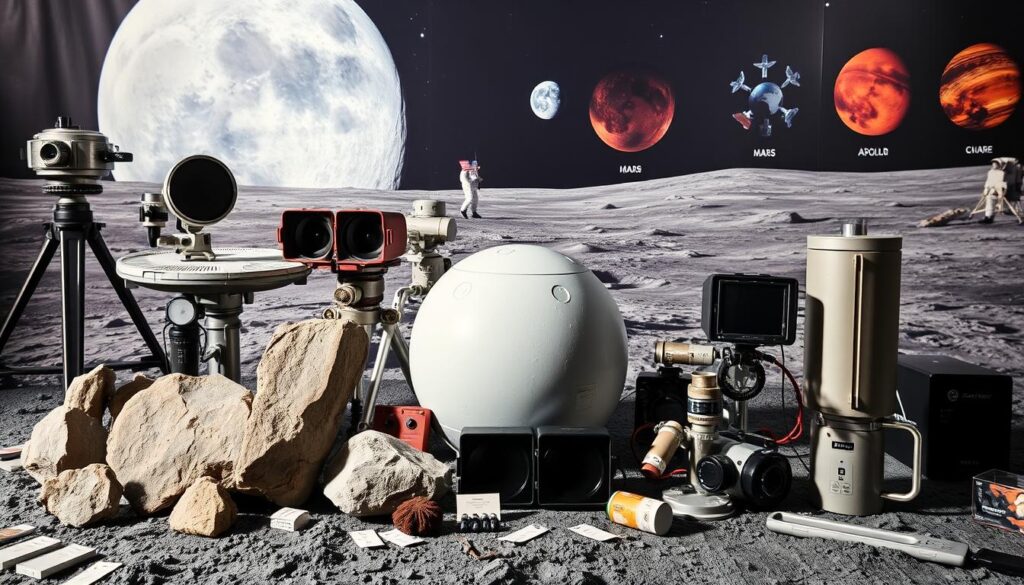
Technological Innovations Driven by Apollo 11
The Apollo 11 mission sparked a wave of new technologies. These changes touched many areas of life, showing how NASA’s work changed our world.
The Apollo 11 mission changed space travel and our daily lives. For example, it led to the development of today’s computers. It also helped create solar panels, a key part of renewable energy.
- Integrated Circuits: Made technology smaller, leading to today’s electronics.
- Advanced Computing: The need for fast computers in space missions helped create today’s systems.
- Materials Science: New materials for space travel have also improved many products we use.
NASA’s work in space technology also helped in education, healthcare, and protecting the environment. These achievements set the stage for future innovators and engineers.
| Technological Innovation | Modern Application |
|---|---|
| Integrated Circuits | Smartphones and computers |
| Solar Panels | Renewable energy systems |
| Advanced Computing | Artificial Intelligence |
| Lightweight Materials | Aerospace and automotive industries |
The Apollo 11 mission’s impact goes beyond its historic achievements. It shows how pushing the boundaries in space can lead to big changes on Earth.
Human Spaceflight and the Legacy of Apollo 11
The Apollo 11 mission was a key moment in space history. It inspired many in the aerospace field. Neil Armstrong, Edwin ‘Buzz’ Aldrin, and Michael Collins flew on a Saturn V rocket.
They made history by being the first humans on the Moon. Their journey also paved the way for more lunar missions. NASA and other space agencies are still working towards these goals.
The Apollo 11 mission showed how important humans are in space. NASA had plans for nine more moon landings after Apollo 11. But, the last three missions were canceled.
Each moon landing showed the power of crewed spaceflight. It amazed the world, with 600 million watching. An incredible 94% of American TV owners saw it live.
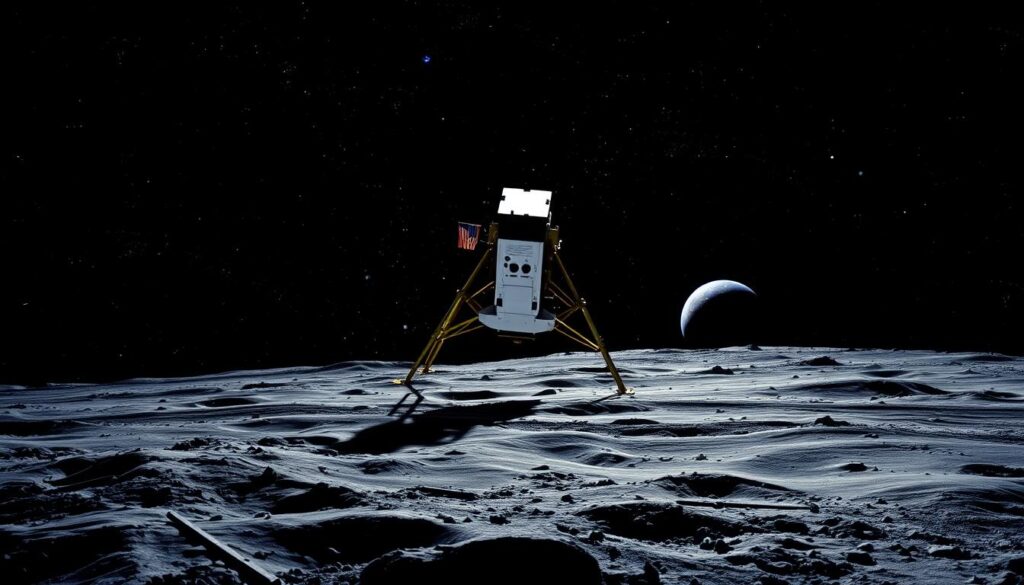
Since Apollo 11, technology has made huge strides. Today’s laptops are much more powerful than the equipment used for the moon landing. This progress could lead to lunar colonies and more space exploration.
Studies like those by Arizona State University’s Center for Meteorite Studies are still important. They show the Moon is still full of mysteries. Discoveries like young volcanic flows and fault lines keep lunar research exciting.
| Aspect | Apollo 11 Achievements | Impact on Future Missions |
|---|---|---|
| First Human Landing | Neil Armstrong and Buzz Aldrin stood on the Moon | Inspired continuous lunar missions and international collaboration |
| Technological Advancements | Used 1960s technology to reach the Moon | Laid groundwork for modern spacecraft and missions |
| Public Interest | 600 million viewers tuned in | Stimulated interest in science and engineering fields |
| Research Contributions | Mapped the lunar surface during missions | Enabled extensive lunar research from Earth-based technologies |
The Apollo program’s legacy still inspires today’s space explorers. It motivates astronauts, engineers, and scientists. Their work is shaped by Apollo 11’s pioneering spirit, showing humanity’s ongoing quest in space.
The Role of NASA in the Apollo Program
The NASA Apollo program was key in space exploration. It brought together thousands of experts for a bold mission to the Moon. Over 2 million people from government and aerospace helped with their skills and ideas.
Project Mercury was the start, with 25 flights and six with astronauts. It taught the skills needed for later missions. The Gemini program then improved by focusing on long flights and docking, crucial for the Moon.
The Apollo program reached a huge goal eight years after President Kennedy’s call. Apollo 13 showed NASA’s quick thinking when disaster struck. The crew’s safe return was thanks to a life-saving system made by NASA’s engineers.
NASA’s work didn’t stop after Apollo. Skylab and the International Space Station followed. The space shuttle flew 135 times, carrying 355 people. The ISS has had people on board since 2000. NASA also works with SpaceX and Orbital ATK now.
Now, NASA is aiming for the Moon again with the Artemis program. It plans to land on the Moon by 2026. The Apollo missions inspire NASA to keep exploring and pushing boundaries.
Inspiring Future Generations through Lunar Exploration
The Apollo 11 mission was a key moment in history. It inspired generations to explore the moon and sparked a love for science, technology, engineering, and mathematics (STEM). It showed the power of human ingenuity and courage. This legacy encourages young people to choose STEM careers, creating a culture of innovation and exploration.
After the moon landing on July 20, 1969, education changed. Schools and universities started teaching in new ways. They focused on hands-on learning, improving critical thinking and problem-solving skills. The mission showed how important science is, motivating students to study hard.
Many organizations were inspired by Apollo to help students. They created programs that connect students with real-world challenges. These programs teach skills needed for future jobs, linking education to work. They promote teamwork and creativity, showing the lasting effect of Apollo on our world.
Today, as we keep exploring space, Apollo 11 is a symbol of what’s possible. It reminds us of the power of dreams and exploration in solving our world’s problems. Inspiring generations to explore the moon starts with the dreams sparked by past missions.
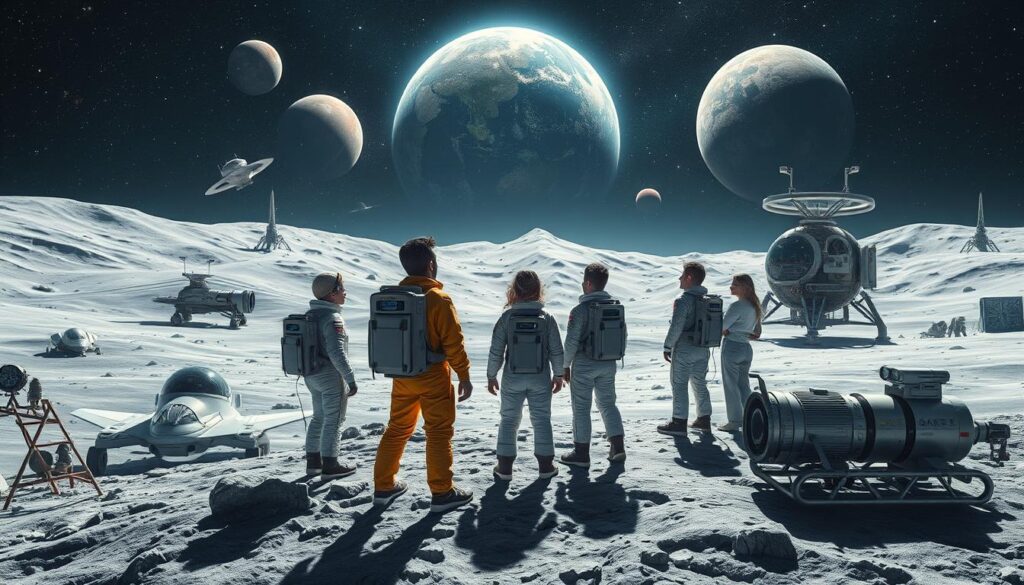
The Geopolitical Context of the Apollo 11 Mission
The Apollo 11 mission took place in a tense time. The Cold War space race was a fierce competition between the U.S. and the Soviet Union. It was more than just a race for who could reach space first. It was about showing off who was better, both in technology and in values.
The Apollo program was key for the U.S. to show its strength and innovation. When the U.S. landed on the Moon in July 1969, it caught the world’s attention. An estimated 600 million people watched, making it a moment of great pride for America.
Many people worked hard on the Apollo program. By 1965, the U.S. was spending almost 5% of its budget on space. This effort showed how the country could come together and achieve great things.
The Apollo 11 mission also opened doors for working together in space. After the mission, talking about teaming up for space projects became more common. This showed a new way of working together, beyond just national interests.
| Aspect | Details |
|---|---|
| Years of Apollo Program | 1963 – 1972 |
| Total Missions | 17 |
| Workers Involved | Hundreds of thousands |
| Astronauts Who Landed on Moon | Six groups |
| Launch Thrust | 7.6 million pounds |
| Return Capsule Weight | 13,000 lbs |
| Viewership of Moon Landing | Hundreds of millions |
| U.S. Investment in Apollo | 5% of government spending by 1965 |
Conclusion
The Apollo 11 mission’s end was a key moment in history. It changed many areas of human achievement. The moon landing showed humanity’s reach and sparked new science and tech advances.
This event changed how we see space travel. It also brought countries together in space missions. This teamwork has been crucial for space progress.
The Apollo 11 legacy inspires today’s space dreams. Looking back, we see how it paved the way for today’s discoveries. It shows us the power of working together towards a goal.
This mission’s impact is still felt today. It teaches us about the value of teamwork and creativity. It shows we can achieve great things when we work together.
FAQ
Who was the first man on the moon?
Neil Armstrong was the first man on the moon. He landed during the Apollo 11 mission on July 20, 1969.
What was the significance of the Apollo 11 mission?
The Apollo 11 mission was a big step in space exploration. It showed humans could land on another celestial body.
What did Neil Armstrong say when he first stepped on the moon?
Neil Armstrong said, “That’s one small step for [a] man, one giant leap for mankind,” as he stepped on the moon.
How did the Apollo 11 mission impact technology?
The Apollo 11 mission led to big tech advancements. These include better computers, materials, and circuits, changing many industries.
What scientific discoveries were made during the Apollo 11 mission?
The astronauts brought back moon rocks and soil. These samples gave us new insights into the moon’s makeup and history.
How did the lunar landing influence the space race?
Apollo 11 showed America’s tech lead during the Cold War. It changed global politics and relations.
What is the legacy of Apollo 11?
Apollo 11 inspired many in STEM fields. It led to new space tech and NASA’s Artemis program for the moon.
How did Apollo 11’s success affect public perception of NASA?
Apollo 11’s success boosted NASA’s image. It showed NASA’s innovation and set it up for future space missions.
What was the journey of Apollo 11 like?
Apollo 11 launched from Kennedy Space Center on July 16, 1969. It took four days to reach the moon. The Lunar Module “Eagle” landed on July 20.
What role did Buzz Aldrin play in the Apollo 11 mission?
Buzz Aldrin was the Lunar Module pilot. He was the second person to walk on the moon, after Neil Armstrong.

